Édith Piaf (1915-1963) is a cultural icon and is universally regarded as France's greatest popular singer. Her ballads, like La Vie en rose (1946) and Non, je ne regrette rien (1960), reflected her life. She appeared sporadically in films.
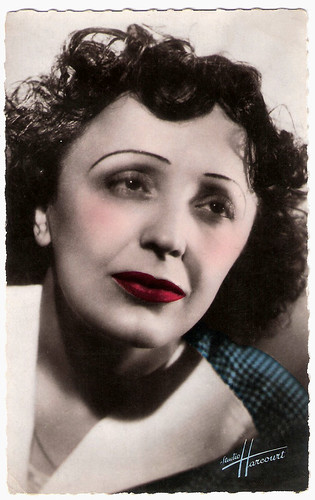
French postcard by Editions O.P., Paris, no. 18. Photo: Studio Harcourt.
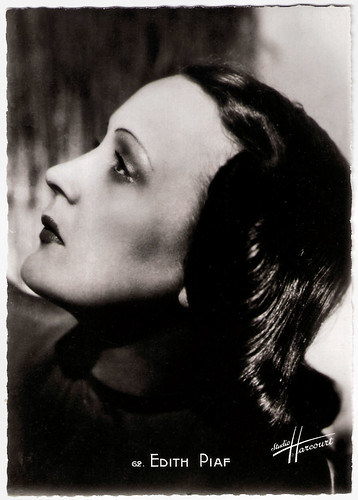
French postcard by S.E.R.P., Paris, no. 62. Photo: Studio Harcourt, Paris.
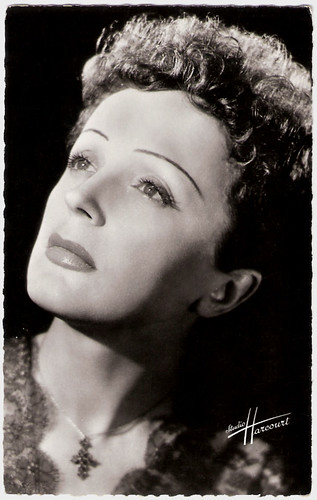
French postcard by Editions du Globe (E.D.U.G.), no. 171. Photo: Studio Harcourt.
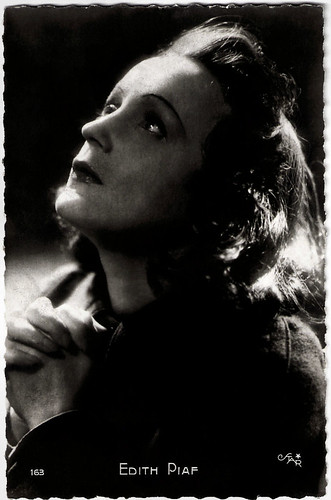
French postcard by Editions P.I., no. 163. Photo: Star.
Despite numerous biographies, much of Édith Piaf's life is shrouded in mystery. She was born Édith Giovanna Gassion in Ménilmontant, one of the poorer districts of Paris, in 1915. She was named Edith after the World War I British nurse Edith Cavell, who was executed for helping French soldiers escape from German captivity. Piaf - a Francilien colloquialism for sparrow - was a nickname she would receive 20 years later.
Her Moroccan-Italian mother, Anita Maillard, worked as a cafe singer under the name Line Marsa. Louis-Alphonse Gassion, Édith's father, was a Norman street acrobat with a past in the theatre. Édith's parents soon abandoned her, and she lived for a short time with her maternal grandmother, who virtually ignored her.
Her father had enlisted with the French Army to fight in World War I. When Louis Alphonse returned in 1918, he decided to send his daughter to live with his mother in Normandy. Later, she joined her father in his acrobatic street performances all over France. Discovering that she had a powerful singing voice which could hold a crowd mesmerised for longer than her father's back flips, Edith decided to follow in her mother's footsteps.
In Paris she went her own way and began singing on the Paris streets while her friend Simone, aka Momone, passed the hat round. In spite of her scruffy street urchin appearance, Edith proved extremely popular with the crowds, her amazingly expressive voice managing to move even the most impassive listener.
She was about 16 when she fell in love with Louis Dupont, a delivery boy and they soon had a child, Marcelle, who died of meningitis at age two.
In 1935 Piaf was discovered by Louis Leplée, owner of the nightclub Le Gerny off the Champs-Élysées. He gave her the nickname that would stay with her for the rest of her life, La Môme Piaf (The Little Sparrow - she was only 1 m 47 tall). Leplée taught her the basics of stage presence and told her to wear a black dress, later to become her trademark apparel.
Leplée ran an intense publicity campaign leading up to her opening night, attracting the presence of many celebrities, including Maurice Chevalier. Her nightclub gigs led to her first two records produced that same year. In 1936, Leplée was murdered and Piaf was questioned and accused as an accessory, but was acquitted. Leplée had been killed by mobsters with previous ties to Piaf.
To rehabilitate her image, she recruited Raymond Asso, with whom she would become romantically involved. He changed her stage name to Édith Piaf, barred undesirable acquaintances from seeing her, and commissioned Marguerite Monnot to write songs that reflected or alluded to Piaf's previous life on the streets. Later that same year Piaf launched a film career, appearing in La garçonne/The Tomboy (Jean Limur, 1937) with Marie Bell.
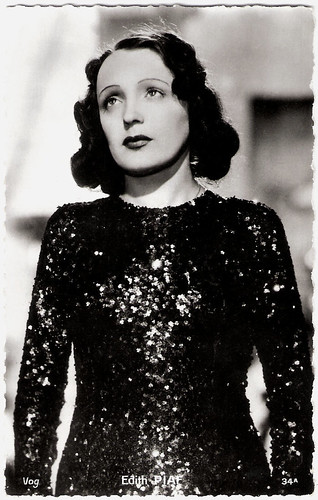
French postcard by Edit. Chantal, Rueil, no. 34A. Photo: Vog.
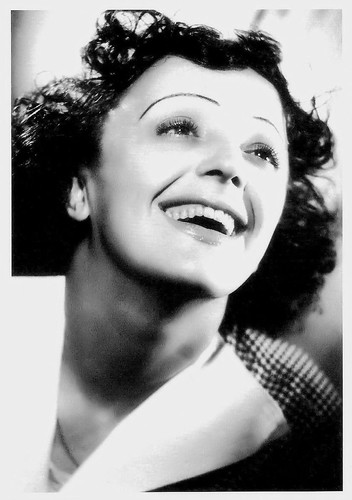
Modern French postcard by Éditions du Désastre, Paris, no. PR 022. Photo: Studio Harcourt, 1946.
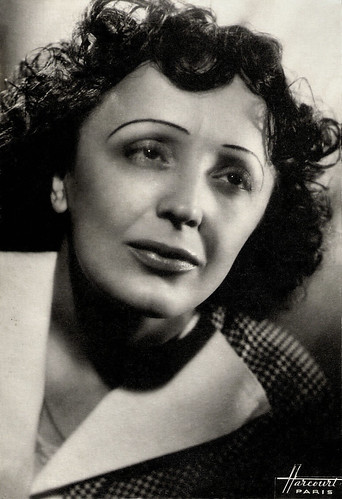
French postcard. Sent in 1948. Photo: Studio Harcourt, Paris.
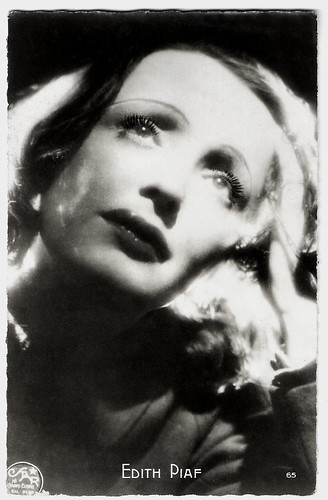
French postcard by O.P., Paris, no. 65. Photo: Star.
In 1940, Édith Piaf co-starred with Paul Meurisse in Jean Cocteau's successful one-act play Le Bel Indifférent (The beautiful indifferent). Piaf and Meurisse were then offered leading roles in the film Montmartre-sur-Seine (Georges Lacombe, 1940) in which the couple starred alongside the famous French actor Jean-Louis Barrault.
She began forming friendships with prominent people, including Chevalier and poet Jacques Borgeat. He wrote the lyrics of many of her songs and collaborated with composers on the tunes.
In 1944, she discovered Yves Montand in Paris, made him part of her act, and became his mentor and lover. They would form a famous double act in the film Etoile sans lumière/Star Without Light (Marcel Blistène, 1945). Within a year, Montand became one of the most famous singers in France, and Piaf broke off their relationship when he had become almost as popular as she was.
During this time she was in great demand and very successful in Paris as France's most popular entertainer. After the war, she became known internationally, touring Europe, the United States, and South America. She scored a major hit in 1946 with Les Trois Cloches, which would later become an English-language smash for The Browns when translated into The Three Bells.
Later that year, she recorded the self-composed number La Vie en Rose, another huge hit that international audiences would come to regard as her signature song. She also sang it in the film Neuf garçons, un coeur/Nine Boys, One Heart (Georges Friedland, 1948), in which she appeared with her new proteges Les Compagnons de la Chanson.
The love of Piaf's life was the married boxing champion Marcel Cerdan. He died in a plane crash in October 1949, while flying from Paris to New York City to meet her. His sudden death left Piaf devastated and she fell in a deep depression. It was the beginning of her downfall, and drugs and alcohol began to take their toll on Piaf’s increasingly fragile health.
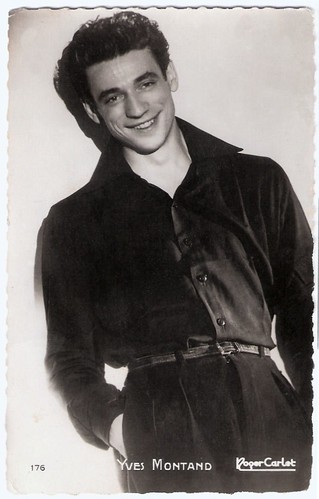
Yves Montand. French postcard by Editions P.I., Paris, no. 176. Photo: Roger Carlet.
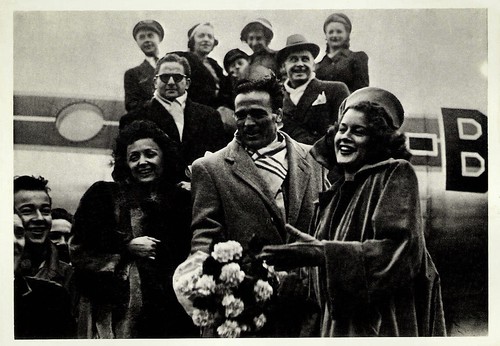
French postcard by Editions Gendre, Paris, no. 27. Photo: Keystone. Caption: Edith Piaf, Marcel Cerdan, March 1948.
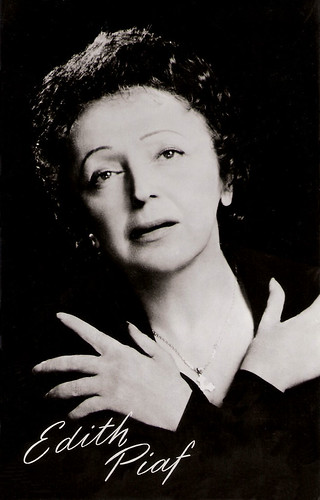
Dutch postcard by Uitg. Takken, Utrecht, no. AX 5247. Photo: Columbia.
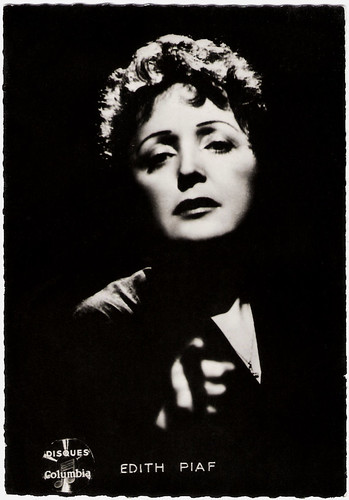
French promotion card by Disques Columbia.
In the early 1950s Édith Piaf would begin a long series of treatments in a private health clinic, in an attempt to wean herself off alcohol and morphine. Yet, while her health continued to decline, Piaf's voice appeared to go from strength to strength.
She also helped launch the career of Charles Aznavour, taking him on tour with her in France and the United States and recording some of his songs.
In 1951 Piaf would fall in love again, throwing herself into a passionate relationship with Eddie Constantine, a young American singer and actor. Later that same year Piaf would demand that her new protege be given a lead role in Marcel Achard's operetta, La p'tite Lili (Little Lili), which Achard was staging at the ABC with Marguerite Monnot. Piaf got her way and helped Constantine launch his career. But after La p'tite Lili’s successful seven month run at the ABC, Piaf and Constantine's relationship also came to an end.
The following year Piaf married singer Jacques Pills and after four years they divorced in 1956. Not long afterward, she suffered an attack of delirium tremens and had to be hospitalised.
In 1954 she appeared in two successful films, in Si Versailles m'était conté/Affairs in Versailles (Sacha Guitry, 1954), a witty history of the Versailles palace, and in French Cancan (Jean Renoir, 1954) about the revival of Paris' most notorious dance.
Piaf achieved lasting fame in Bruno Coquatrix's famous Paris Olympia music hall where she gave several series of concerts from 1955 till 1962.
In late 1958, she met another up-and-coming songwriter, Georges Moustaki, and made him her latest lover and improvement project. Teaming once again with Marguerite Monnot, Moustaki co-wrote Milord, an enormous hit that topped the charts all over Europe in early 1959 and became Piaf's first successful single in the U.K.
She made one last film, Les amants de demain/The Lovers of Tomorrow (Marcel Blistène, 1959) opposite Michel Auclair. In 1962, she wed Théo Sarapo (Theophanis Lamboukas), a Greek hairdresser-turned-singer and actor who was 20 years her junior. The couple sang together in some of her last engagements.
In 1963 Édith Piaf died of liver cancer at Plascassier, on the French Riviera, aged 47. Although she was denied a funeral mass by the Roman Catholic archbishop of Paris because of her lifestyle, her funeral procession drew tens of thousands of mourners onto the streets of Paris and the ceremony at the cemetery was attended by more than 100,000 fans.
The film Piaf (Guy Casaril, 1974) depicted her early years, and starred Brigitte Ariel, with early Piaf songs performed by Betty Mars. Piaf's relationship with Cerdan was depicted in the film Édith et Marcel (Claude Lelouch, 1983) with Marcel Cerdan Jr. in the role of his father and Évelyne Bouix portraying Piaf. Piaf...Her Story...Her Songs (George Elder, Bernard Salzmann. 2003) is a documentary starring Raquel Bitton in her performance tribute to Edith Piaf.
La Môme/La Vie en rose (Olivier Dahan, 2007) debuted at the Berlin Film Festival in February 2007. The film features Marion Cotillard in the role that won her the Golden Globe, the BAFTA award and the Academy Award for Best Actress.
At AllMusic, Steve Huey writes about Édith Piaf: “Still revered as an icon decades after her death, ‘the Sparrow’ served as a touchstone for virtually every chansonnier, male or female, who followed her. Her greatest strength wasn't so much her technique, or the purity of her voice, but the raw, passionate power of her singing.”
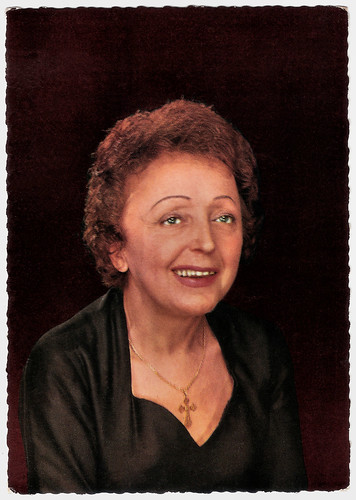
French postcard by E.D.U.G., no. 270. Photo: Sam Lévin.
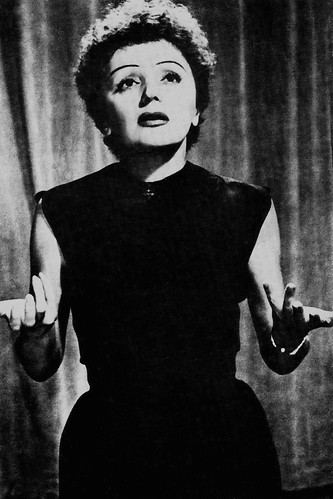
French postcard by Ébullitions, no. 66.
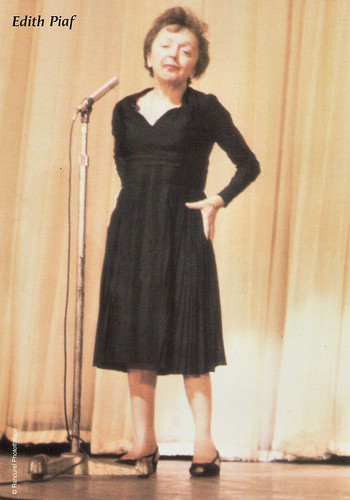
French postcard by L'Encyclopédie de la Chanson Française, 2003. Photo: Universal Collections.
Edith Piaf sings La Vie En Rose in Neuf garçons, un coeur/Nine Boys, One Heart (1948). Source: bigproblem11 (Daily Motion).
Sources: Steve Huey (AllMusic), Gary Brumburgh (IMDb), RFI Musique, Wikipedia, and IMDb.

French postcard by Editions O.P., Paris, no. 18. Photo: Studio Harcourt.

French postcard by S.E.R.P., Paris, no. 62. Photo: Studio Harcourt, Paris.

French postcard by Editions du Globe (E.D.U.G.), no. 171. Photo: Studio Harcourt.

French postcard by Editions P.I., no. 163. Photo: Star.
The Little Sparrow
Despite numerous biographies, much of Édith Piaf's life is shrouded in mystery. She was born Édith Giovanna Gassion in Ménilmontant, one of the poorer districts of Paris, in 1915. She was named Edith after the World War I British nurse Edith Cavell, who was executed for helping French soldiers escape from German captivity. Piaf - a Francilien colloquialism for sparrow - was a nickname she would receive 20 years later.
Her Moroccan-Italian mother, Anita Maillard, worked as a cafe singer under the name Line Marsa. Louis-Alphonse Gassion, Édith's father, was a Norman street acrobat with a past in the theatre. Édith's parents soon abandoned her, and she lived for a short time with her maternal grandmother, who virtually ignored her.
Her father had enlisted with the French Army to fight in World War I. When Louis Alphonse returned in 1918, he decided to send his daughter to live with his mother in Normandy. Later, she joined her father in his acrobatic street performances all over France. Discovering that she had a powerful singing voice which could hold a crowd mesmerised for longer than her father's back flips, Edith decided to follow in her mother's footsteps.
In Paris she went her own way and began singing on the Paris streets while her friend Simone, aka Momone, passed the hat round. In spite of her scruffy street urchin appearance, Edith proved extremely popular with the crowds, her amazingly expressive voice managing to move even the most impassive listener.
She was about 16 when she fell in love with Louis Dupont, a delivery boy and they soon had a child, Marcelle, who died of meningitis at age two.
In 1935 Piaf was discovered by Louis Leplée, owner of the nightclub Le Gerny off the Champs-Élysées. He gave her the nickname that would stay with her for the rest of her life, La Môme Piaf (The Little Sparrow - she was only 1 m 47 tall). Leplée taught her the basics of stage presence and told her to wear a black dress, later to become her trademark apparel.
Leplée ran an intense publicity campaign leading up to her opening night, attracting the presence of many celebrities, including Maurice Chevalier. Her nightclub gigs led to her first two records produced that same year. In 1936, Leplée was murdered and Piaf was questioned and accused as an accessory, but was acquitted. Leplée had been killed by mobsters with previous ties to Piaf.
To rehabilitate her image, she recruited Raymond Asso, with whom she would become romantically involved. He changed her stage name to Édith Piaf, barred undesirable acquaintances from seeing her, and commissioned Marguerite Monnot to write songs that reflected or alluded to Piaf's previous life on the streets. Later that same year Piaf launched a film career, appearing in La garçonne/The Tomboy (Jean Limur, 1937) with Marie Bell.

French postcard by Edit. Chantal, Rueil, no. 34A. Photo: Vog.

Modern French postcard by Éditions du Désastre, Paris, no. PR 022. Photo: Studio Harcourt, 1946.

French postcard. Sent in 1948. Photo: Studio Harcourt, Paris.

French postcard by O.P., Paris, no. 65. Photo: Star.
The love of Piaf's life
In 1940, Édith Piaf co-starred with Paul Meurisse in Jean Cocteau's successful one-act play Le Bel Indifférent (The beautiful indifferent). Piaf and Meurisse were then offered leading roles in the film Montmartre-sur-Seine (Georges Lacombe, 1940) in which the couple starred alongside the famous French actor Jean-Louis Barrault.
She began forming friendships with prominent people, including Chevalier and poet Jacques Borgeat. He wrote the lyrics of many of her songs and collaborated with composers on the tunes.
In 1944, she discovered Yves Montand in Paris, made him part of her act, and became his mentor and lover. They would form a famous double act in the film Etoile sans lumière/Star Without Light (Marcel Blistène, 1945). Within a year, Montand became one of the most famous singers in France, and Piaf broke off their relationship when he had become almost as popular as she was.
During this time she was in great demand and very successful in Paris as France's most popular entertainer. After the war, she became known internationally, touring Europe, the United States, and South America. She scored a major hit in 1946 with Les Trois Cloches, which would later become an English-language smash for The Browns when translated into The Three Bells.
Later that year, she recorded the self-composed number La Vie en Rose, another huge hit that international audiences would come to regard as her signature song. She also sang it in the film Neuf garçons, un coeur/Nine Boys, One Heart (Georges Friedland, 1948), in which she appeared with her new proteges Les Compagnons de la Chanson.
The love of Piaf's life was the married boxing champion Marcel Cerdan. He died in a plane crash in October 1949, while flying from Paris to New York City to meet her. His sudden death left Piaf devastated and she fell in a deep depression. It was the beginning of her downfall, and drugs and alcohol began to take their toll on Piaf’s increasingly fragile health.

Yves Montand. French postcard by Editions P.I., Paris, no. 176. Photo: Roger Carlet.

French postcard by Editions Gendre, Paris, no. 27. Photo: Keystone. Caption: Edith Piaf, Marcel Cerdan, March 1948.

Dutch postcard by Uitg. Takken, Utrecht, no. AX 5247. Photo: Columbia.

French promotion card by Disques Columbia.
Alcohol and Morphine
In the early 1950s Édith Piaf would begin a long series of treatments in a private health clinic, in an attempt to wean herself off alcohol and morphine. Yet, while her health continued to decline, Piaf's voice appeared to go from strength to strength.
She also helped launch the career of Charles Aznavour, taking him on tour with her in France and the United States and recording some of his songs.
In 1951 Piaf would fall in love again, throwing herself into a passionate relationship with Eddie Constantine, a young American singer and actor. Later that same year Piaf would demand that her new protege be given a lead role in Marcel Achard's operetta, La p'tite Lili (Little Lili), which Achard was staging at the ABC with Marguerite Monnot. Piaf got her way and helped Constantine launch his career. But after La p'tite Lili’s successful seven month run at the ABC, Piaf and Constantine's relationship also came to an end.
The following year Piaf married singer Jacques Pills and after four years they divorced in 1956. Not long afterward, she suffered an attack of delirium tremens and had to be hospitalised.
In 1954 she appeared in two successful films, in Si Versailles m'était conté/Affairs in Versailles (Sacha Guitry, 1954), a witty history of the Versailles palace, and in French Cancan (Jean Renoir, 1954) about the revival of Paris' most notorious dance.
Piaf achieved lasting fame in Bruno Coquatrix's famous Paris Olympia music hall where she gave several series of concerts from 1955 till 1962.
In late 1958, she met another up-and-coming songwriter, Georges Moustaki, and made him her latest lover and improvement project. Teaming once again with Marguerite Monnot, Moustaki co-wrote Milord, an enormous hit that topped the charts all over Europe in early 1959 and became Piaf's first successful single in the U.K.
She made one last film, Les amants de demain/The Lovers of Tomorrow (Marcel Blistène, 1959) opposite Michel Auclair. In 1962, she wed Théo Sarapo (Theophanis Lamboukas), a Greek hairdresser-turned-singer and actor who was 20 years her junior. The couple sang together in some of her last engagements.
In 1963 Édith Piaf died of liver cancer at Plascassier, on the French Riviera, aged 47. Although she was denied a funeral mass by the Roman Catholic archbishop of Paris because of her lifestyle, her funeral procession drew tens of thousands of mourners onto the streets of Paris and the ceremony at the cemetery was attended by more than 100,000 fans.
The film Piaf (Guy Casaril, 1974) depicted her early years, and starred Brigitte Ariel, with early Piaf songs performed by Betty Mars. Piaf's relationship with Cerdan was depicted in the film Édith et Marcel (Claude Lelouch, 1983) with Marcel Cerdan Jr. in the role of his father and Évelyne Bouix portraying Piaf. Piaf...Her Story...Her Songs (George Elder, Bernard Salzmann. 2003) is a documentary starring Raquel Bitton in her performance tribute to Edith Piaf.
La Môme/La Vie en rose (Olivier Dahan, 2007) debuted at the Berlin Film Festival in February 2007. The film features Marion Cotillard in the role that won her the Golden Globe, the BAFTA award and the Academy Award for Best Actress.
At AllMusic, Steve Huey writes about Édith Piaf: “Still revered as an icon decades after her death, ‘the Sparrow’ served as a touchstone for virtually every chansonnier, male or female, who followed her. Her greatest strength wasn't so much her technique, or the purity of her voice, but the raw, passionate power of her singing.”

French postcard by E.D.U.G., no. 270. Photo: Sam Lévin.

French postcard by Ébullitions, no. 66.

French postcard by L'Encyclopédie de la Chanson Française, 2003. Photo: Universal Collections.
Edith Piaf sings La Vie En Rose in Neuf garçons, un coeur/Nine Boys, One Heart (1948). Source: bigproblem11 (Daily Motion).
Sources: Steve Huey (AllMusic), Gary Brumburgh (IMDb), RFI Musique, Wikipedia, and IMDb.
No comments:
Post a Comment